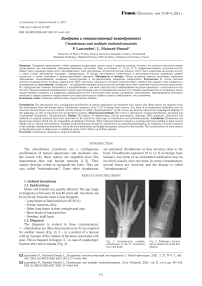Chondromas and multiple enchondromatosis
Автор: Lascombes Pierre, Mainard-Simard Laurence
Журнал: Гений ортопедии @geniy-ortopedii
Рубрика: Оригинальные статьи
Статья в выпуске: 4 т.27, 2021 года.
Бесплатный доступ
Introduction The chondromas are a cartilaginous proliferation of mature appearance and moderate size, reason why these tumors are regarded more like hamartomas than real benign tumor. Chondromas represent 10 to 12 % of benign bone tumors. Any bone of an enchondral ossification may be involved. Several bones can be involved, and the disease is called “chondromatosis”. In the review we describe clinical and radiological findings of this pathology as well as indications for reconstructive surgery. Material and methods The review is dedicated to isolated chondromas, periosteal and extraskeletal chondromas, chondromatosis. Results The aspects of epidemiology, clinical presentation, radiology, MRI, prognosis, indications and methods of surgical treatment have been described in the article for each types of chondroma and enchondromatosis. Conclusion Chondromas are benign bone tumors which may be responsible of pathologic fractures. Their surgical treatment consists in curettage and bone grafting or bone-cement filling with or without osteosynthesis. Multiple enchondromatosis should be considered as an osteochondrodysplasia. Its treatment is not the treatment of the multiple chondromas themselves, but of the bone deformities and length discrepancy induced by the disorder. The transformation of some tumors in chondrosarcomas in adolescence or adulthood needs a strict follow up of these patients.
Chondromas, diagnostics, surgical treatment
Короткий адрес: https://sciup.org/142230200
IDR: 142230200 | DOI: 10.18019/1028-4427-2021-27-4-441-445
Список литературы Chondromas and multiple enchondromatosis
- Mazabraud A. Anatomie pathologique osseuse tumorale: Experience personnelle. Paris : Springer-Verlag. 1994. 552 p.
- Bone and soft tissue tumors / M. Campanacci, F. Bertoni, P. Bacchini, W.F. Enneking. Translated by Notini S. New-York: Springer-Verlag. 1990. 1131 p.
- Lichtenstein L., Hall J.E. Periosteal chondroma: a distinctive benign cartilage tumor // J. Bone Joint Surg. Am. 1952. Vol. 24 A, No 3. P. 691-697.
- Is PET-CT an accurate method for the differential diagnosis between chondroma and chondrosarcoma? / R. Jesus-Garcia, A. Osawa, R. Zon Filippi, D.C.M. Viola, M. Korukian, G. de Carvalho Campos Neto, J. Wagner // SpringerPlus. 2016. Vol. 5. Article No 236. DOI: 10.1186/s40064-016-1782-8.
- Radiologic Follow-Up of Untreated Enchondroma and Atypical Cartilaginous Tumors in the Long Bones / C. Deckers, B.H. Schreuder, G. Hannink, J.W. de Rooy, I.C. van der Geest // J. Surg. Oncol. 2016. Vol. 114, No 8. P. 987-991. DOI: 10.1002/jso.24465.
- Outcome of conservative and surgical treatment of enchondromas and atypical cartilaginous tumors of the long bones: retrospective analysis of 228 patients / G.W. Omlor, V. Lohnherr, J. Lange, S. Gantz, G. Mechtersheimer, C. Merle, P. Raiss, J. Fellenberg, B. Lehner // BMC Musculoskelet. Disord. 2019. Vol. 20, No 1. P. 134. DOI: 10.1186/s12891-019-2502-7.
- Ollier L. De la dyschondroplasie // Bull. Soc. Chir. (Lyon). 1899. Vol. 3. P. 22-27.
- Ollier Disease: Pathogenesis, Diagnosis, and Management / A. Kumar, V.K. Jain, M. Bharadwaj, R.K. Arya // Orthopedics. 2015. Vol. 38, No 6. P. e497-e506. DOI: 10.3928/01477447-20150603-58.
- Jaffe H.L. Tumors and tumorous conditions of the bones and joints. Philadelphia: Pa. Lea & Febiger. 1958. 629 p.
- PTHR1 mutations associated with Ollier disease result in receptor loss of function / A. Couvineau, V. Wouters, G. Bertrand, C. Rouyer, B. Gérard, L.M. Boon, B. Grandchamp, M. Vikkula, C. Silve // Hum. Mol. Genet. 2008. Vol. 17, No 18. P. 2766-2775. DOI: 10.1093/hmg/ddn176.
- Maffucci A. Di un casa di encondroma ed angioma multiplo. Contribuzione alia genesi embrionale dei tumori // II Movemento Med. Chir. Napoli. 1881. Vol. 3. P. 399-412. (in Italian)
- Finidori G., Rigault P., Padovani J.P. Anomalies de croissance du squelette anti-brachial dans la maladie exostosante et dans la maladie d'Ollier // Chir. Pediatr. 1979. Vol. 20, No 2. P. 143-148.
- Limb Length Discrepancy and Angular Deformity due to Benign Bone Tumors and Tumor-like Lesions / T.J. Reif, J. Matthias, A.T. Fragomen, S.R. Rozbruch// J. Am. Acad. Orthop. Surg. Glob. Res. Rev. 2021. Vol. 5, No 3. P. e00214. DOI: 10.5435/JAAOSGlobal-D-20-00214.
- Shapiro F. Ollier's disease. An assessment of angular deformity, shortening, and pathological fracture in twenty-one patients // J. Bone Joint Surg. Am. 1982. Vol. 64, No 1. P. 95-103.
- Flexible Intramedullary Nail Use in Limb Lengthening / D. Popkov, A. Popkov, T. Haumont, P. Journeau, P. Lascombes // J. Pediatr Orthop. 2010. Vol. 30, No 8. P. 910-918. DOI: 10.1097/BPO.0b013e3181f0eaf9.
- Elastic intramedullary nailing as a complement to Ilizarov's method for forearm lengthening: a comparative pediatric prospective study / T. Jager, D. Popkov, P. Lascombes, A. Popkov, P. Journeau // Orthop. Traumatol. Surg. Res. 2012. Vol. 98, No 4. P. 376-382. DOI: 10.1016/j.otsr.2012.01.007.
- Ollier's disease limb lengthening: should intramedullary nailing be combined with circular external fixation? / D. Popkov, P. Journeau, A. Popkov, T. Haumont, P. Lascombes // Orthop. Traumatol. Surg. Res. 2010. Vol. 96, No 4. P. 348-353. DOI: 10.1016/j.otsr.2010.01.002.
- Percutaneous epiphysiodesis using transphyseal screws (PETS) / J.P. Métaizeau, J. Wong-Chung, H. Bertrand, P. Pasquier // J. Pediatr. Orthop. 1998. Vol. 18, No 3. P. 363-369.


